Scariff, Co. Clare
Scariff (sometimes spelt Scarriff) Poor Law Union was formally declared on the 25th July 1839 and covered an area of 170 square miles. Its operation was overseen by an elected Board of Guardians, 26 in number, representing its 10 electoral divisions as listed below (figures in brackets indicate numbers of Guardians if more than one):
Co. Clare: Feakle (4), Killaloe (3), Killuran (2), Kilnoe (2), Orgunnella (2), Scariff (4).
Co. Galway: Clonrush 92), Woodford (2).
Co. Clare and Co. Galway: Mountshannon.
The Board also included 8 ex-officio Guardians, making a total of 34. The Guardians met on alternate Thursdays.
The population falling within the Union at the 1831 census had been 47,894 with divisions ranging in size from Mountshannon (population 2,198) to Feakle (8,744).
The new Scariff Union workhouse was erected on a six-acre site half a mile to the south of Scariff. Designed by the Poor Law Commissioners' architect George Wilkinson, the building was based on one of his standard plans to accommodate 600 inmates. Its construction cost £6,400 plus £1,050 for fittings etc. The workhouse was declared fit for the reception of paupers on 1st October 1841, and received its first admissions on 11th May 1842.
The site location and layout of the Scariff workhouse are shown on the 1898 map below.
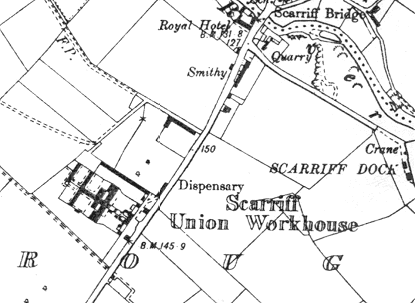
Scariff workhouse site, 1898.
The boundary wall at the south of the site had a central entrance, and a small single-storey block at each side.
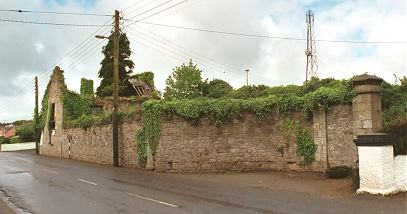
Scariff workhouse site entrance from the east, 2002
© Peter Higginbotham.
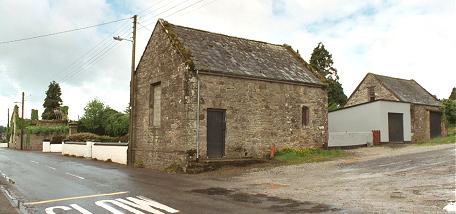
Scariff workhouse site from the east, 2002
© Peter Higginbotham.
An entrance and administrative block contained a porter's room and waiting room at the centre with the Guardians' board room on the first floor above.
The main accommodation block had the Master's quarters at the centre, with male and female wings to each side. At the rear, a range of single-storey utility rooms such as bakehouse and washhouse connected through to the infirmary and idiots' wards via a central spine containing the chapel and dining-hall.
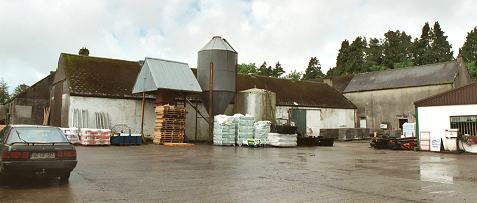
Scariff central spine from the north-east, 2002
© Peter Higginbotham.
During the famine in the mid-1840s, Scariff was one of the worst affected unions. Additional premises were hired, and the workhouse stables were fitted up to accommodate an additional 40 inmates but it was virtually impossible to cope with the huge numbers seeking relief. In January 1847, the Limerick Chronicle reported that the workhouse was:
Later that month, the union had virtually run out of money and for a while had to close the workhouse. Workhouse staff also suffered from the famine — in November 1847, the workhouse matron, Mrs William O'Brien, died from fever caught in the discharge of her duties.
As in a number of other distressed unions, the Poor Law Commissioners dissolved the Board of Guardians and appointed their own 'vice-guardians' to manage the union. In 1849, many such unions belatedly received some financial assistance via the British Government's rate-in-aid scheme. A measure of the scale of the pressure on the union is the fact that in 1851, Scariff was providing workhouse accommodation to 4,121 inmates spread across 17 different buildings.
Following the famine, the size of some unions, particularly in the west or Ireland, was reduced and more than thirty new unions were created. In 1852, the western part of the Scariff Union went to become part of the new Tulla Union.
The workhouse was burnt down in June 1921 — said to have been carried out by the IRA to prevent the building being used as a barracks by the 'Black and Tans' — a British reservist force. A few of the workhouse outbuildings survive. Part of the site is now occupied by an agricultural supplies company.
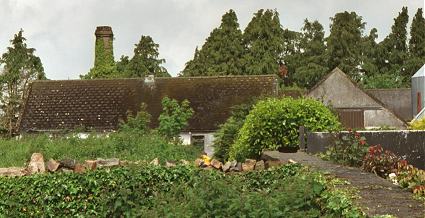
Scariff centre of site from the south-east, 2002
© Peter Higginbotham.
Records
Note: many repositories impose a closure period of up to 100 years for records identifying individuals. Before travelling a long distance, always check that the records you want to consult will be available.
- Clare County Library, The Manse, Harmony Row, Ennis.
Bibliography
Links
- None.
Unless otherwise indicated, this page () is copyright Peter Higginbotham. Contents may not be reproduced without permission.


